What is a migraine?
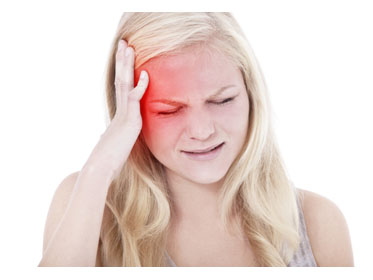 Migraine is not just a headache, but also a complex neurological event with different kinds of symptoms. Besides an intense or throbbing headache, some common symptoms include hypersensitivity to light or sounds, nausea and vomiting, visual disturbance, fatigue, and difficulty concentrating. Others also have sensitivity to touch or smell. Some have only one from this list and others have none.
Migraine is not just a headache, but also a complex neurological event with different kinds of symptoms. Besides an intense or throbbing headache, some common symptoms include hypersensitivity to light or sounds, nausea and vomiting, visual disturbance, fatigue, and difficulty concentrating. Others also have sensitivity to touch or smell. Some have only one from this list and others have none.
Migraine attacks are very unique, it varies for each individual, and even in one patient the headache attacks vary from one attack to the next. It is usually intense or can be described as a throbbing pain on one side, or sometimes, both sides of the head. Usually, people with a migraine headache feel the pain behind one ear or in the temples, although any part of the head can be affected.
What causes migraines?
The exact cause of a migraine headache is not fully understood. However, there are studies that point out to some possible causes of migraine. Some researchers believe that migraine is an effect of an abnormal changes or amount of substances produced in the brain. When these substances increase more than its normal level, they can cause inflammation. The inflammation in the brain will then cause blood vessels in the brain to swell which in turn presses the nerves in the brain, thereby producing pain sensations.
Genes also play a role in migraines. It has been linked and proven that individuals who get migraines may have abnormalities on genes that control some of the functions of specific brain cells.
Here are some things are more common on individuals who have migraines:
- Women
- People between the ages of 15 and 55
- Those who have a family history of migraines or other types of severe headaches
Professionals also believe that migraines are induced by a variety of factors and events, known as the “triggering factors”. These can vary from person to person and sometimes don’t always lead to migraine attack. A combination of these factors/triggers—is more likely to cause an attack. Many people with migraine, especially women, tend to have migraine attacks triggered by: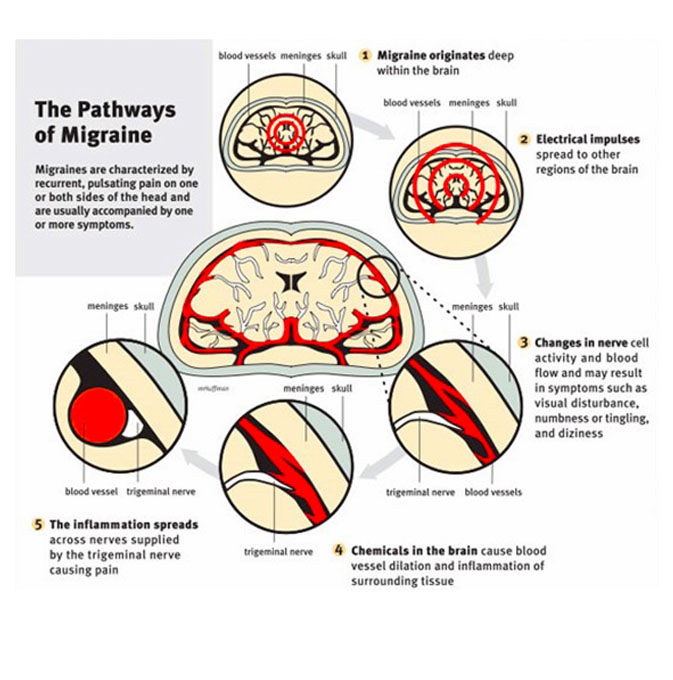
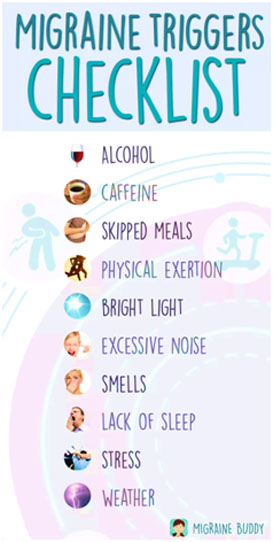
- Skipped meals
- Loud noises, bright lights, or strong odors
- Hormonal changes during the menstrual cycle
- Sleep deprivation
- Over fatigued/stress
- Alcohol intake
- Too much caffeine
- Climate changes
- Food that has nitrates like processed luncheon meats and hotdogs
- Foods that contain Tyramine, like cheese, soy products, fava beans, hard sausages, smoked fish, and Chianti wine
Are There Different Types Of Migraine?
Yes, there are two different forms of migraine. In 1988, the IHS or International Headache Society created a classification system for migraine. This classification system has been adopted by WHO (World Health Organization). The International Classification of Headache Disorders system presented different names to the different types of migraine and headaches that involve different symptoms. This helps doctors to diagnose and treat them (The migraine trust, 2016).
| The Most Common Types Of Migraine | |
| Migraine with aura | Migraine without aura |
– Seeing flashing lights, blind spots, wavy or zigzag lines – Numbness and tingling in the face or hands – Feeling mentally “fuzzy” – Disturbed sense of smell, taste, or touch
|
|
How can I differentiate a migraine from other types of headaches?
The following table is a summary of the most common types of headaches with its distinguishing characteristics.
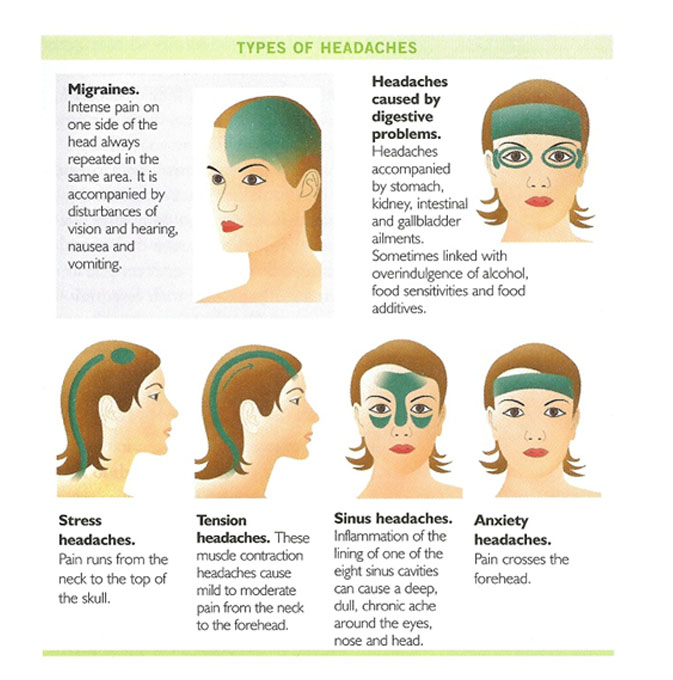
What Should I Do When A Migraine Begins?
If you think that you have a migraine, book an appointment to your doctor to come up with a plan for managing migraine attacks. Also, keeping a list of treatment methods can help especially for the next migraine attack.
When migraine symptoms begin:
- If your doctor prescribed a migraine medicine, take it right away as indicated or advised.
- Drink plenty of fluids as tolerated, if you don’t feel nauseated during your migraine attack.
- Lie down and take a rest in a dark and quiet room, especially when you feel sensitive to lights and sounds.
The following might be useful:
- Putting a cold cloth on your head
- Applying pressure to the area where the pain is felt
- A massage
- Other rel
How Are Migraines Treated?
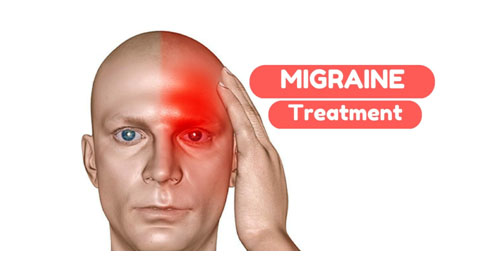 Currently, migraines have no cure. However, migraines can be managed with a doctor’s help. Treatments are available to help make your migraines decrease in frequency and intensity.
Currently, migraines have no cure. However, migraines can be managed with a doctor’s help. Treatments are available to help make your migraines decrease in frequency and intensity.
- There are two categories of medicines for the treatment of migraines:
- Acute Treatment – for pain and other symptoms of a migraine in progress. It is also called “abortive” treatment, includes aspirin, acetaminophen, or NSAIDs (nonsteroidal anti-inflammatory drugs) like ibuprofen.
- Preventive Treatment – for reduction of frequency and severity of headaches. These are drugs that serve as prophylaxis to “prevent” the next migraine attack.
- Lifestyle changes. Healthy habits can reduce the number of migraine attacks. These are the following:
- Avoid or limit triggering factors
- Set your body clock, wake up and go to bed the same time every day.
- Eat nutritious foods and do not skip meals.
- Maintain a regular physical activity—exercise!
- Avoid caffeine or alcohol intake.
- Engage and find ways to lessen and cope with stress.
- Acupuncture – activates the restful state and the relaxation response, thereby reducing stress to the brain and the body.
- Counseling – helps prevent migraines that are caused by fluctuations or changes in the level of the brain substances related to depression or anxiety.
References:
More than “just a headache” – the migraine trust. (2016). Retrieved October 16, 2016, from https://www.migrainetrust.org/about-migraine/migraine-what-is-it/more-than-just-a-headache/
Retrieved October 18, 2016, from https://hartp.neurology.ucla.edu/IMAGES/MIGRAINEHandout.pdf
Healthline, T. (2005). Migraine drugs. Retrieved October 20, 2016, from https://www.healthline.com/health/migraine-drugs#Overview1
Retrieved October 20, 2016, from https://www.womenshealth.gov/files/assets/docs/fact-sheets/migraine.pdf
Choices, N. (2016, July 28). Migraine – treatment. Retrieved October 20, 2016, from https://www.nhs.uk/Conditions/Migraine/Pages/Treatment.aspx
Images:
Retrieved October 16, 2016, from https://www.healthandlovepage.com/wp-content/uploads/2016/02/Frankincense-Oil-for-Migraine-Relief-and-Headaches.jpg
Retrieved October 16, 2016, from https://www.candida-albicans-cure.com/images/Migraine.jpg
Retrieved October 16, 2016, from https://www.headaches.org/wp-content/uploads/2007/10/migraine-pathways.jpg
Retrieved October 17, 2016, from https://i0.wp.com/www.migrainebuddy.com/wp-content/uploads/2015/07/Migraine-Trigger-Checklist_new1.png
Retrieved October 18, 2016, from https://awesomejelly.com/wp-content/uploads/2015/09/headache2.jpg
Retrieved October 19, 2016, from https://www.massagesecrets.net/Images/migraine_massage.jpg
Retrieved October 19, 2016, from https://i.ytimg.com/vi/y_uDBrdzdQw/maxresdefault.jpg
